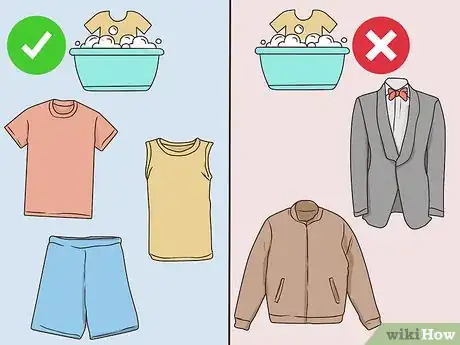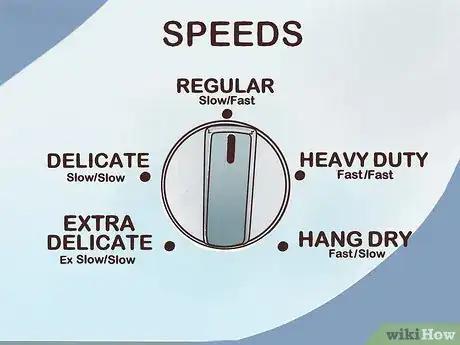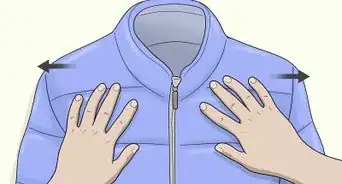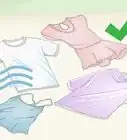This article was co-authored by Susan Stocker. Susan Stocker runs and owns Susan’s Green Cleaning, the #1 Green Cleaning Company in Seattle. She is well known in the region for outstanding customer service protocols — winning the 2017 Better Business Torch Award for Ethics & Integrity —and her energetic support of green cleaning practices.
There are 22 references cited in this article, which can be found at the bottom of the page.
This article has been viewed 132,057 times.
Even brand new clothes aren’t necessarily clean. Prepare them for washing by removing their tags, turning them inside out, and fastening zippers. Separate your brand new clothes into light and dark colors, and set delicate items aside, too. Set your washing machine’s temperature, load size, and speed settings. Load your washing machine with your brand new clothes, add detergent, and turn the machine on.
Things You Should Know
- Remove the tags and stickers before you wash new clothes.
- Follow the instructions on the care label to launder a new garment.
- Use cold water unless it states otherwise on the label and take your clothes out of the washer as soon as the cycle is over before air- or machine-drying.
- You do not need to wash new swimwear, outerwear, formal wear, or jeans.
Steps
Readying Your Clothes for Washing
-
1Identify which clothes need to be washed. There are a few clothing items that don’t require washing before you wear them. Swimsuits, outerwear (jackets, etc.), and event wear (formal dresses and tuxedos), for instance, don’t need to be washed before you wear them.[1] Jeans, likewise, should never be washed when brand-new.[2] Anything else, however, should be washed even if it’s brand new.
-
2Remove the tags. Clothes that are brand new often sport two kinds of tags – label tags that describe the product and/or brand, and security tags. Label tags are easy to spot and remove, since they hang off the clothing item and are affixed with a small plastic clip. Security tags are often hidden behind pockets or other areas of fabric. Check your new clothes carefully for all tags before washing them for the first time.[3]
- Use a pair of scissors to remove any price tags on the clothing. Don’t forget to slip the plastic clip out of the clothes, too.
- Set the tags aside in a safe place. That way, if you wish to return a piece of clothing, you won't have to dig around in the trash can for the tag later.
Advertisement -
3Check the care label. Before washing anything, carefully read the washing instructions on the item’s care label. This label will provide guidance regarding exactly how to clean the clothing. For instance, some types of fabric might require you to hand wash and/or hang dry them. Other clothes can be cleaned in washing machines, but may need cold or warm water.[4]
-
4Determine which clothes are likely to leach dye if the care label is not specific. Garment care instructions are written in order to prevent you from causing your new clothes to lose color when washed. Most of the time, determining if clothes are likely to leach dye is as easy as consulting the care label. However, if your new clothes do not have a care label, ask the salesperson who sold them to you what the garment is made of, and whether it is likely to leach dye.[5]
- Cotton, wool, and silk are more likely to leach dye than synthetic materials like polyester, nylon, and acrylic. Wash clothes of these materials separately on the gentle cycle in cold water.
-
5Test for dye transfer if necessary. If you cannot consult the salesperson who sold you the new clothes, or if the salesperson is ignorant as to the material your new clothes were made of, you can test the clothing yourself. Dip a white cloth in a bit of the laundry detergent you intend to use to wash your clothes that are brand new. Dab an inconspicuous portion of the garment (for instance, an inner seam) with the white cloth. Check the cloth intermittently as you dab the garment. If any color comes out, wash the new item separately in cold water on the gentle cycle.[6]
- Set the dye. If you suspect or know that your new clothes will leach dye, you can purchase a dye fixative from your local tailor or clothier. Specific directions for use will vary according to the product you’ve selected. Generally, however, you can simply wash the clothing along with a small amount of the dye fixative on a cold water cycle.[7]
-
6Separate your clothes. If you’re planning on washing clothes that are brand new along with clothes that are not, or planning on washing several items of brand new clothing, you will need to segregate your clothes into appropriate categories. These categories are determined by the information on the care tags.[8]
- For instance, you typically should not wash light clothes with dark clothes. Other brand-new clothes need to be washed separately because they are delicate.
- Consult the care tag(s) on your brand new clothes to determine how to best separate your clothes.
-
7Turn your clothes inside out. If you’re washing brand new clothes that are colored along with other clothes (whether they’re brand new or older), turn your brand new items inside out. This will prevent the dye from running, and will reduce the chances of staining other garments even if the dye does run.[9]
-
8Unbutton your clothes. If you’re washing any brand new clothes that are buttoned, unfasten the buttons. This will prevent the clothes from rending during the washing process.[10]
-
9Zip up your zippers. If you have any brand new clothes with zippers, zip them up. Unzipped zippers might snag other clothes as they tumble about the washing machine.[11]
Choosing the Proper Settings
-
1Use cold water. Cold water is appropriate for washing brand new clothes that are delicate, such as sweaters, lacy tops, mesh jerseys, and the like. It is also the best option for washing clothes that might shrink. Finally, if you have a piece of brand new clothing that is colored or features both light and dark colors, wash it in cold water to prevent the colors from running.[12]
-
2Set your washer to use warm water. Warm water is an acceptable way to wash brand new clothes that are light-colored or white. Warm water – when mixed with detergent – will effectively lift soil and stains, as well as remove bacteria.[13]
-
3Choose the appropriate load size. If your laundry load fills the washing machine to about three-quarters of its capacity or more, you will need to select the “large” setting on your washer. If your washer is filled about halfway with new clothes, you should select the “medium” setting. If your washer is filled to about one-third of its capacity or less, you should select the “small” load setting.[14]
- Choosing the right load size will prevent wasting water and get your clothes washed faster.
-
4Decide on your washer speed. Washing machines can spin at different speeds. Higher speeds should be reserved for more durable clothes. Gentle or delicate cycles should be reserved for brand new clothes like women’s lingerie, sweaters, and other items that could be damaged by rough handling.[15]
Picking Your Detergent
-
1Choose a high-efficiency laundry detergent. High-efficiency washing machines use less water than traditional washing machines, and specialized high-efficiency laundry detergents must be used when washing clothes in such a machine. However, most high-efficiency detergents can also be used in traditional washing machines, too.[16]
-
2Select a cold water laundry detergent when using cold water. Cold water laundry detergents are specially designed for use in cold water. If you are washing new clothes that are colored, you’ll need to wash them in cold water to prevent color bleeding.[17]
- Cold water detergents generally work best in water between 60 and 75 degrees Fahrenheit (16 to 24 degrees Celsius). Adjust your washing machine’s water temperature to the appropriate temperature range, if possible.
- Washing your brand new clothes (or even your older clothes) in cold water can save energy, which means you save money.
-
3
-
4Purchase an environmentally friendly detergent. Traditional detergents often contain chemicals that could be discharged into local waterways, affecting aquatic life and, potentially, the communities that use those waterways. Fortunately, there are many environmentally friendly detergents that use nontoxic alternatives or, at the very least, fewer chemicals. Choose one of these to reduce your negative environmental impact.[20]
- You can often identify an environmentally friendly detergent by its name. Look for detergents with names preceded by the prefix “eco” or “bio.”
Doing the Laundry
-
1Load the washing machine. Place your clothes that are brand new in the washing machine. If you’ve separated your brand new clothes into more than one load – for instance, whites and colors – remember not to throw them all in together. Add detergent according to manufacturer recommendations.[21]
-
2Turn the machine on. After all your temperature, load size, and other settings are appropriately selected, you’re ready to get started. If you are unsure of how long the washing cycle will take, ask someone more familiar with the machine or consult your washing machine’s user guide. If you’re washing your brand new clothes at the laundromat, look for an indicator on the machine that will tell you how long the washing cycle will last.[22]
-
3Take your clothes out as soon as possible. Wet clothing is more likely to color bleed. Therefore, take your brand new clothing out of the washer as soon as the cycle is completed (usually it will take about 20 minutes).[23]
- Hang your clothes on the line or place them in the dryer per care label instructions.
-
4Hand wash anything that needs to be washed by hand. If the care label on your brand new clothes indicates that you must wash something by hand, do not attempt to wash it in the washing machine. Instead, fill a sink basin with cool water and mix in a bit of dishwashing liquid until the water is sudsy. Soak your clothes that are brand new in the water for 10 minutes. Drain the sink and rinse your clothes in cold water.[24]
- Just as you did with brand new clothes that you washed in the machine, separate clothes you wash by hand according to their color.
- Lay hand-washed clothing flat on a clothing rack or towel to dry.
Expert Q&A
Did you know you can get expert answers for this article?
Unlock expert answers by supporting wikiHow
-
QuestionHow do I remove mold spores from clothing?
 Susan StockerSusan Stocker runs and owns Susan’s Green Cleaning, the #1 Green Cleaning Company in Seattle. She is well known in the region for outstanding customer service protocols — winning the 2017 Better Business Torch Award for Ethics & Integrity —and her energetic support of green cleaning practices.
Susan StockerSusan Stocker runs and owns Susan’s Green Cleaning, the #1 Green Cleaning Company in Seattle. She is well known in the region for outstanding customer service protocols — winning the 2017 Better Business Torch Award for Ethics & Integrity —and her energetic support of green cleaning practices.
Green Cleaning Expert Hot water and white vinegar is excellent for this! Vinegar kills roughly 80% of mold spores, so it's really good at disinfecting clothing and getting rid of that moldy smell. If you're doing this with a washing machine, make sure you pour the vinegar into the water after it has filled up with water. Don't do it before the machine fills, and don't put it in the dispenser.
Hot water and white vinegar is excellent for this! Vinegar kills roughly 80% of mold spores, so it's really good at disinfecting clothing and getting rid of that moldy smell. If you're doing this with a washing machine, make sure you pour the vinegar into the water after it has filled up with water. Don't do it before the machine fills, and don't put it in the dispenser. -
QuestionHow to keep the clothes from shrinking?
 Community AnswerDo not use hot water in the wash, and lay it out to dry instead of using the dryer. Heat tends to shrink fabrics.
Community AnswerDo not use hot water in the wash, and lay it out to dry instead of using the dryer. Heat tends to shrink fabrics.
References
- ↑ http://www.elle.com/culture/a37076/do-you-really-have-to-wash-new-clothes-before-wearing-them/
- ↑ https://www.theguardian.com/fashion/2014/oct/24/why-you-should-never-ever-wash-your-jeans-unless-you-really-really-have-to
- ↑ http://www.wolfstad.com/2006/01/hidden-security-tags-in-old-navy-jeans/
- ↑ http://www.whowhatwear.com/are-you-doing-laundry-right-weve-got-the-dos-and-donts/slide3
- ↑ http://indian.ifas.ufl.edu/FCS/colorsbleedingnews.htm
- ↑ https://www.thespruce.com/what-is-colorfastness-1900691
- ↑ http://www.pburch.net/dyeing/FAQ/settingdye.shtml
- ↑ http://www.whowhatwear.com/are-you-doing-laundry-right-weve-got-the-dos-and-donts/
- ↑ https://www.cleanipedia.com/in/laundry-washing/how-to-wash-new-coloured-clothes-prevent-colour-from-running
- ↑ https://www.realsimple.com/home-organizing/cleaning/laundry/how-do-laundry
- ↑ http://www.dummies.com/home-garden/home-improvement/cleaning-stain-removal/how-to-use-your-washing-machine/
- ↑ http://www.whowhatwear.com/are-you-doing-laundry-right-weve-got-the-dos-and-donts/
- ↑ http://www.whowhatwear.com/are-you-doing-laundry-right-weve-got-the-dos-and-donts/
- ↑ http://www.dummies.com/home-garden/how-to-wash-clothes-in-a-washing-machine/
- ↑ http://www.dummies.com/home-garden/how-to-wash-clothes-in-a-washing-machine/
- ↑ http://www.consumerreports.org/cro/laundry-detergents/buying-guide
- ↑ http://www.consumerreports.org/laundry-cleaning/how-to-keep-your-black-clothes-looking-their-best/
- ↑ https://www.wikihow.com/Use-a-Wine-Aerator
- ↑ http://thesweethome.com/reviews/the-best-laundry-detergent/
- ↑ https://www.savewatersavemoney.co.uk/water-efficiency-tips-advice/view/75/why-should-i-use-eco-friendly-detergents.html
- ↑ http://www.consumerreports.org/laundry-cleaning/how-to-keep-your-black-clothes-looking-their-best/
- ↑ http://www.dummies.com/home-garden/home-improvement/cleaning-stain-removal/how-to-use-your-washing-machine/
- ↑ http://www.whowhatwear.com/are-you-doing-laundry-right-weve-got-the-dos-and-donts/
- ↑ https://books.google.com/books?id=y8ehDQAAQBAJ&lpg=PA159&pg=PA168#v=onepage&q&f=false
About This Article
If you’ve bought brand new clothes, it’s best to give them a wash before you wear them. Check the labels of your new clothes for their recommended washing instructions. If you have any clothes made of cotton, wool, or silk, wash these separately in case they leach dye. Otherwise, wash your light and dark clothes separately for the same reason. Once you’ve separated your clothes, turn them inside out, load them into your washing machine, and add some laundry detergent. Wash them on a cold setting with a regular speed, unless your clothes are delicate, in which case, use a slow speed. For more tips, including how to choose a good laundry detergent, read on!










































































